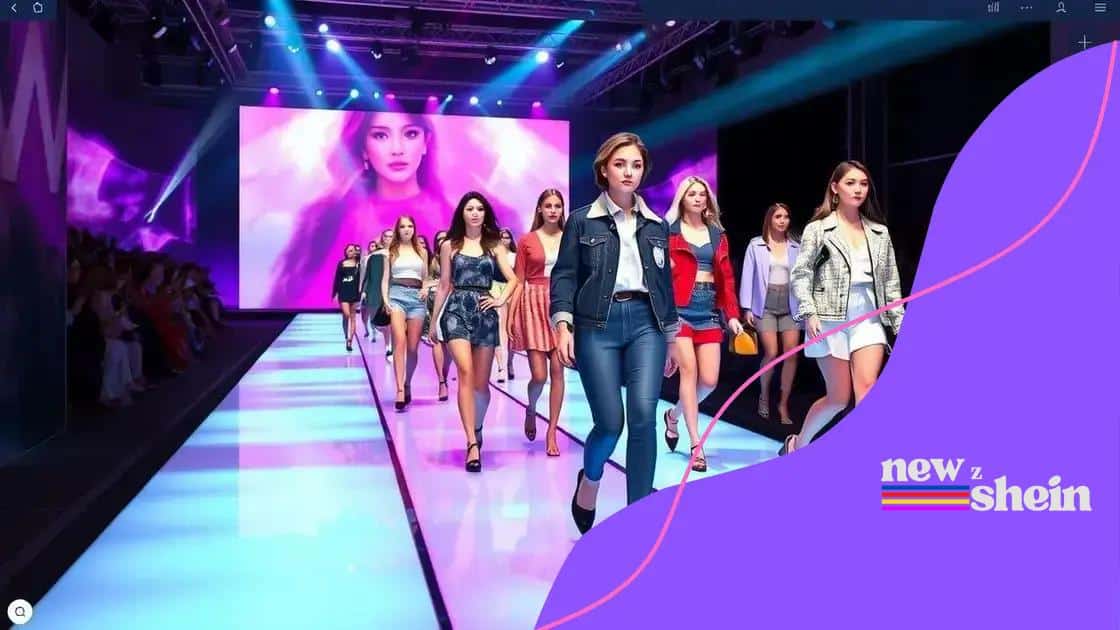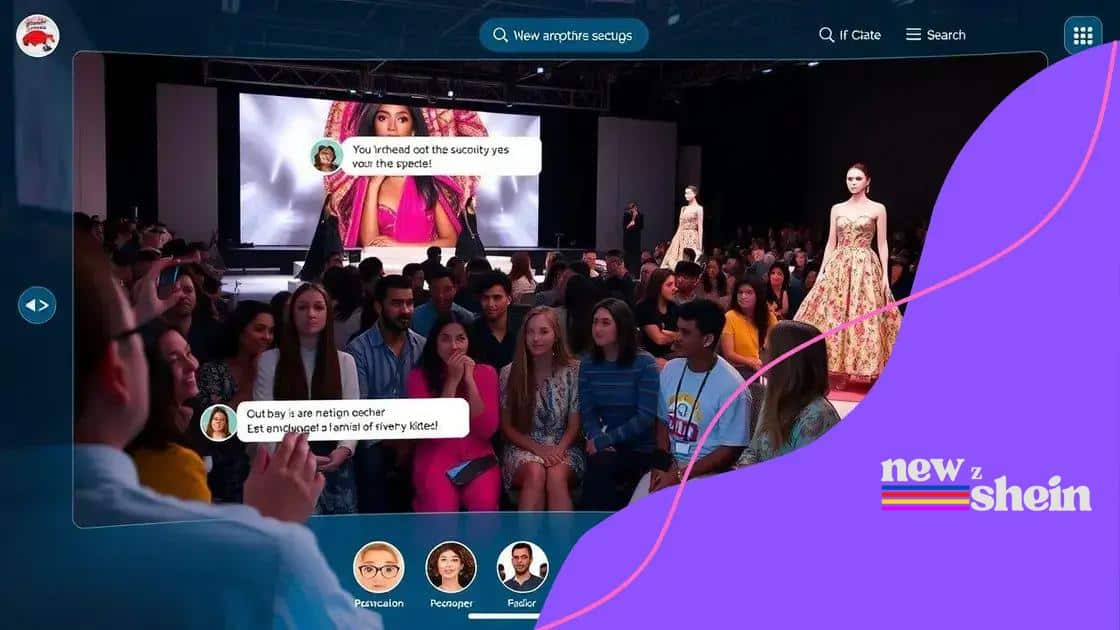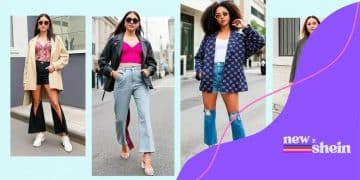Shein’s fashion show virtual events: a new trend

Shein’s virtual fashion shows revolutionize the fashion industry by providing global accessibility, enhancing viewer engagement through interactive features, and utilizing advanced technologies, making fashion more inclusive and memorable.
Shein’s fashion show virtual events have transformed the way we experience fashion. Have you ever wondered how technology shapes the runway? Let’s explore the innovative elements of these virtual showcases.
Understanding Shein’s virtual fashion shows
Understanding Shein’s virtual fashion shows can seem complex at first, but it reveals a fascinating intersection of technology and style. These shows represent a significant shift in the fashion industry, embracing digital platforms to reach broader audiences.
Virtual fashion shows leverage advanced technology to create immersive experiences. They allow designers to showcase their collections without the constraints of a physical runway. Shifting to a virtual format has not only enhanced accessibility, but it also opens doors to innovative presentations.
Key Elements of Shein’s Virtual Shows
Several key elements make these shows unique:
- High-Quality Streaming: Viewers can enjoy crystal-clear visuals that capture intricate designs.
- Engagement Features: Interactive elements allow viewers to participate in polls and comment during the show.
- Behind-the-Scenes Content: Exclusive looks at the design and production process transform the viewing experience.
This engaging format allows the audience to connect more deeply with the items showcased. Moreover, Shein’s use of technology encourages viewer participation in real time. Imagine being able to click on a dress and purchase it instantly right from your screen!
The integration of social media further amplifies the reach of these events. Fashion enthusiasts share their favorite moments across platforms, generating buzz and excitement around new collections. This strategy not only builds community but also creates a lively atmosphere where trends can spread quickly.
In summary, Shein’s virtual fashion shows go beyond traditional formats. They fuse technology and fashion to create engaging experiences that resonate with global audiences. This new approach shapes the future of fashion, encouraging innovation and accessibility like never before.
Key technologies used in virtual events
Key technologies used in virtual events play a crucial role in shaping the experiences that brands like Shein offer. These advancements create immersive environments that captivate audiences and deliver engaging fashion showcases.
One of the main technologies is streaming software. This allows high-quality video to be transmitted over the internet, ensuring that viewers can enjoy a seamless experience. The reliability of this technology is vital for keeping audiences engaged throughout the show.
Interactive Features
Many virtual events include interactive elements, enhancing viewer participation:
- Live Chats: Audiences can ask questions or comment during the show, building a live conversation.
- Polls and Voting: Viewers can express their preferences in real time, influencing the event dynamically.
- Augmented Reality: This technology allows participants to visualize products in their own environments, making shopping more interactive.
Furthermore, platforms that support social media integration amplify the reach of virtual fashion events. As viewers share their experiences on different channels, they contribute to a wider conversation about trends and styles. This not only promotes the show but also encourages community engagement.
Another technological advancement is 360-degree video. This immersive format allows viewers to experience the runway from multiple angles, making them feel as if they are part of the event. Such technology makes the viewer’s experience more dynamic and personal.
Overall, leveraging these key technologies enables brands like Shein to reach global audiences effectively. By creating engaging and interactive virtual events, fashion becomes accessible and exciting for everyone.
How virtual fashion shows engage audiences

How virtual fashion shows engage audiences is an exciting aspect of modern fashion. By combining technology and creativity, these shows invite viewers into a unique experience. One significant method of engagement is through enhanced interactivity. Viewers can participate in live polls, provide feedback, and even ask questions during the show.
Another important factor is the use of social media. Through platforms like Instagram and TikTok, audiences are encouraged to share their opinions, outfits, and favorite moments. This creates a buzz around the event and extends its reach beyond the actual viewing time. The connection formed through social media also builds a community of fashion enthusiasts.
Live Interactions
Incorporating live interactions makes the audience feel more involved. There are several ways to achieve this:
- Q&A Sessions: Hosts can answer viewer questions about collections in real time, increasing engagement.
- Viewers’ Choice: Audiences can vote on outfits they would like to see more of, making it a collaborative event.
- Instant Reactions: Viewers can express their thoughts via chat, creating a lively dialogue during the show.
This interactive element transforms passive viewers into active participants, making the experience memorable. Additionally, the use of augmented reality (AR) enhances engagement further. Viewers can virtually try on clothing items or see how they fit into their lives without leaving home.
The combination of high-quality streaming technology and engaging content captivates audiences. When viewers feel connected to the fashion being shown, they are more likely to purchase items inspired by the show. As a result, fashion brands increasingly focus on creating engaging virtual experiences that resonate with consumers.
The future of online fashion events
The future of online fashion events looks bright and full of possibilities. As technology continues to evolve, these events will become more immersive and interactive. Future fashion shows will likely use advanced technologies that enhance viewer participation and engagement.
One major trend is the integration of virtual reality (VR). This technology allows viewers to experience fashion shows as if they were physically present. Wearing VR headsets, attendees can walk around the virtual venue, seeing collections up close. This level of immersion changes the way people connect with fashion.
Innovative Features on the Horizon
Fashion brands are already exploring new features for their online events:
- Personalized Experiences: Attendees may receive tailored content based on their preferences, creating a more engaging journey.
- AI-Powered Recommendations: Artificial intelligence can suggest outfits and styles during shows, helping viewers find what they love.
- Expanded Collaboration: Different designers and influencers could collaborate in joint events, building a sense of community.
The growth of social media will also continue to play a vital role. As audiences share their experiences online, they expand the reach of these virtual shows significantly. This creates organic buzz and encourages more people to attend future events.
Moreover, sustainability will be a key focus. Future fashion events will prioritize eco-friendly practices. Online formats reduce the carbon footprint of traditional shows by eliminating travel and resource use associated with physical venues. By focusing on sustainable practices, brands can align with consumer values while showcasing their collections.
Overall, the future of online fashion events promises a blend of technology, creativity, and sustainability. With engaging experiences on the horizon, audiences will find more ways to connect with their favorite brands and styles than ever before.
Comparing virtual shows to traditional runways
Comparing virtual shows to traditional runways highlights significant differences in how fashion is presented and experienced. While both serve the purpose of showcasing designs, the methods and audience engagement vary greatly. Traditional runways often rely on physical presence, where models walk down a catwalk in front of selected audiences. This creates a glamorous atmosphere, but it limits the reach to those who can attend.
In contrast, virtual fashion shows break down geographical barriers. Anyone with an internet connection can access these events, making fashion more inclusive. This widespread accessibility allows brands to connect with global audiences, allowing for a greater fan base.
Engagement Techniques
Another area of comparison is the engagement techniques used:
- Real-Time Interaction: Virtual shows often incorporate live chats, enabling viewers to comment and ask questions during the event.
- Social Media Integration: Audiences can instantly share their favorite looks on platforms like Instagram, creating a viral buzz.
- Diverse Content: Virtual formats can offer behind-the-scenes footage and interviews, enriching the viewer experience beyond the runway.
This interactivity adds a new dimension to how fashion is consumed. Viewers can participate actively, rather than just observing. Moreover, the virtual environment encourages a more casual and personal atmosphere, allowing viewers to connect with the brands on a deeper level.
While traditional fashion shows have their charm, the virtual model offers innovation and accessibility. Brands can showcase their collections creatively and engage audiences in real-time. The future of fashion may very well lean towards these digital experiences, providing endless possibilities for engagement and expression.
FAQ – Frequently Asked Questions about Virtual Fashion Shows
What are the main advantages of virtual fashion shows?
Virtual fashion shows offer global accessibility, allowing audiences from anywhere to view the collections in real-time.
How do virtual shows enhance audience engagement?
They incorporate interactive features like live chats, polls, and social media integration, enabling viewers to participate actively.
What role does technology play in virtual fashion events?
Technology enhances presentation quality, allows for immersive experiences using VR, and facilitates real-time interaction with the audience.
Will virtual fashion shows replace traditional runway events?
While they won’t completely replace traditional shows, virtual fashion shows will likely continue to grow in popularity and complement them.





